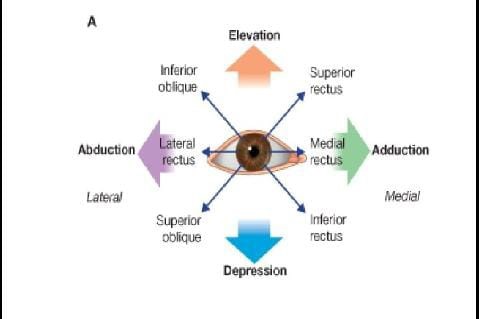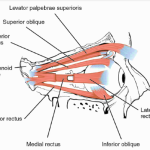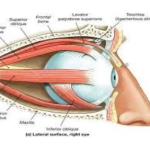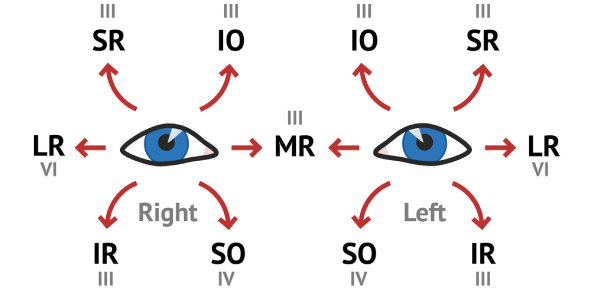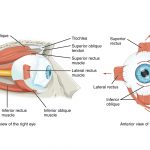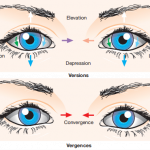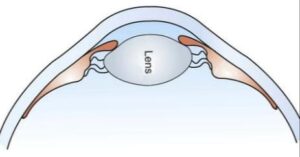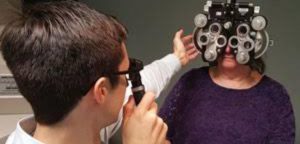The eyes are the visual organ and eyeball moves includes voluntary or involuntary movements to increase the field of vision, to reduce blurring.
This movements are controlled by a set of extra-ocular muscles of each eye. These are four rectus muscles – superior (SR), inferior (IR), medial (MR) and lateral (LR) and two oblique muscles – superior (SO), inferior (IO). They moves the eyeball around vertical, horizontal and anteroposterior axes.
The ocular movements are of three types –
- Uniocular movements,
- Binocular movements,
- Supranuclear movements.
- Uniocular movements: It is refers to the movement of one eye, are also called ductions and consists of-
- Adduction: Movements of nasal side (outward) around the vertical axes.
- Abduction: Movements of temporal side (inward) around the vertical axes.
- Supraductions: It is also called the elevation, movements of upward around the horizontal axes.
- Infraduction: It is also called the depression, movements of downward around the horizontal axes.
- Incycloduction: Also called intorsion. It is the movement of internal rotation or medial rotation, in which superior pole of the cornea (12 O’ clock point) moves medially.
- Excycloduction: Also called extorsion. It is the movement of external rotation or lateral rotation, in which superior pole of the cornea (12 O’ clock) moves laterally.
Vertical movements of elevation and depression are produced by the horizontal axes. Horizontal movements of adduction and abduction are produced by vertical axes. Around the anteroposterior axes the movements produced are clockwise or anti-clockwise (torsional movements).
- Binocular movements: It refers to the movement of two eyes symmetrically in the same direction or opposite direction. These are of two types – versions and vergences.
- Versions: It refers to the symmetric movements of both eyes in same direction. When the two eyes move in the same direction, i.e. right, left, up, down the movements are termed as versions. It also known as conjugate movements. These include-
- Dextroversion: The movements of both eye to the right gaze. It is produced by synchronous contraction of right lateral rectus and left medial rectus.

Levoversion: The movements of both eyes to the left gaze. It is formed by synchronous contraction of left lateral rectus and right medial rectus.

Supraversion: The movements of both eyes to the up gaze in primary position. It is caused by simultaneous contraction of bilateral superior rectus and inferior obliques.

Infraversion: The movements of both eyes to the down gaze in primary position. It is caused by synchronous contractions of bilateral inferior rectus and superior obliques.

Dextroelevation: The movements of both eyes to the gaze up and right. It results due to simultaneous action of right superior rectus and left inferior oblique.

Levoelevation: The movements of both eyes to the gaze up and left. It is formed by the simultaneous contraction of left superior rectus and right inferior oblique.

Dextrodepression: The movements of both eyes to the gaze down and right. It results due to synchronous action of right inferior rectus and left superior oblique.

Levodepression: The movements of both eyes to the gaze down and left. It produced due to synchronous contraction of left inferior rectus and right superior oblique.

- Dextrocycloversion: It is the rotational movement of upper limbus of both eyes towards the right. It forms when the head is titled towards left shoulder.
- Levocycloversion: It is the rotational movement of both eyes towards the left. It forms when the head is titled towards the left shoulder.
- Vergence: It refers to the symmetric movements of both eyes in opposite direction. When the two eyes move in the opposite directions, i.e. both eyes moving inwards or outwards, the movements are termed as vergences. It also known as disconjugate movements. These include-
- Convergence: Movements of right eye to the right and in and left eye to the left and in, simultaneous inward movement. Formed by contraction of medial rectus.

Divergence: Movements of right eye to right and out and left eye to the left and in, simultaneous outward movement. Formed by contraction of lateral rectus.

- Agonist – Movement of the muscle in any given direction is called agonist.
- Synergist – Movements of the two in the same direction are called synergist. It acts together with the agonist to form a given movements.
- Antagonist – Movements of the muscle in the opposite direction in the same eye.
When a person is looking toward his left side, left lateral rectus is agonist, right medial rectus is synergist, and left medial rectus and right lateral rectus are the antagonists.
- Contralateral synergist – Simultaneously movements of the two eyes in the same direction formed by two muscles one from each eye. These are called yolk muscles.
- Contralateral antagonist – These are also the movements of two muscles each from one eye but they have opposite action.
Diagnostic positions of gaze: There are nine diagnostic positions of gaze. These are –
One primary position – It forms by the eyes when fixating a distant object straight ahead.
Four secondary positions – It forms by the eyes while looking straight up, straight down, to the right and to the left.
Four tertiary positions – It forms by the combination of vertical and horizontal movements. These are the dextroelevation, dextrodepression, levoelevation, levodepression.
Six cardinal positions – It forms by the 12 extraocular muscles in their main field of action. These are dextroversion, levoversion, dextroelevation, levoelevation, dextrodepression and levodepression.
Diagnostic positions of gaze: Primary position (E), Secondary positions (B, D, F, H), Tertiary position (A, C, G, I), Cardinal positions (A, C, D, F, G I).
- Supranuclear movements: There are basic supranuclear control of eye movements which keeps the two eyes yoked together. Also known as fixation movements, during head movements or movements of visual world it stabilize image on the fovea centralis. These are described below –
- Versions: Symmetric movements of both eyes in the same direction, also called conjugate movements. These are of following subtype –
- Saccades – It occurs when the gaze shifts from one object to another, they are performed to form the image of an object quickly on the fovea. It is a jerky conjugate movements and its direction and velocity is too rapid for visual processing, so it cannot be corrected during their course. These are of two types –
- Voluntary saccades – It brings new objects of interest on the fovea centralis.
- Involuntary saccades – It generated to correct the preceding slow deviations of the eyes from the target.
- Pursuits – It is smooth following movements which track slow moving objects and keep them stable on the fovea centralis. These are of two types –
- Voluntary pursuits – It occurs when the moving objects become tracked.
- Involuntary pursuits – It occurs when visual patter continuously displaced.
- Vestibular movements – It is slow conjugate movements, it operate through the vestibular system. It is effective in compensating for the effects of head movements in disturbing visual fixation.
- Optokinetic movements: It is slow involuntary conjugate movements, it hold the images on the retina during sustained head rotation.
- Position maintenance: It maintain a specific gaze position. Rapid micro-movements called flips and slow micro-movements called drifts.
- Vergence: It is a slow disconjugate movements, it allows focussing an object which is moves away or fixation shifts from one object to another at a different distance. These are of two types –
- Convergence: In which both eyes focus on an object moving towards the individual, it occurs when eyes moves nasally.
- Divergence: In which both eyes focus on an object moving away from the eyes, it occurs when the eyes moves temporally.

